 |
| Mallam Subramanyeswaraswamy Temple (front view) |
Mallam (மல்லம்), a quaint village located in Chittamur Mandal (சித்தாமூர் மண்டல்), SPSR Nellore (நெல்லூர்) district, Andhra Pradesh Pin Code 524403. The village is also known in the local dialect of Telugu as “Thirugu Mallam” (திருகு மல்லம்) (meaning “turn back”) owing to the unique natural phenomenon where the water from nearby lakes would fill up the nearby fields whenever there were rains and return back to the lake. Inscription calls this village as Thiruvanmur (திருவான்மூர்) (S.I.I. Vol. XII, no. 106). Mallam (Nellore) should not be confused with Mallam village in Pithapuram Mandal, East Godavari district, Andhra Pradesh or with Gudimallam village in Sri Kalahasti Mandal in Chittur district, Andhra Pradesh.
The geographical Coordinates are 13° 57' 0" North (latitude), 80° 7' 0" East (longitude). The main occupation of the area is agriculture and allied activities. It is located 63 km towards South from District head quarters Nellore. It is 46 km from Gudur (கூடூர்), 30 km from Nayudupettai (நாயுடுபேட்டை), 8 km from Chittamur, 488 km from State capital Hyderabad. Gudur , Srikalahasti , Nellore , Venkatagiri are the nearby towns to Mallam. From Chennai you may enjoy the comfort of driving through NH 16 (previously National Highway 5 i.e., Chennai - Calcutta National Highway). Take diversion to your left at 'Koottu road' 4 way junction before Naydupeta. Surprisingly you will find the state and rural roads are good for smooth driving.
The hamlet is part of Mallam Panchayat and as per census 2011 it has a population of 3829 (males 1998 and females 1831 and around 934 families). The village has a junior collage, primary and secondary Zilla Parishad high schools and two private schools.
Architecture
Mallam is home to the Subramanyeswaraswamy temple. It was constructed by the Pandya king Kullothunga Bhupathy. The temple belongs to 630 A.D. and was further extended / renovated in 10th and 11th centuries by Pallava, Chola and Vijayanagara rulers. The prime deity is Lord Subramanyeswaraswamy (a.k.a Lord Murugan) and it is devoid of hand. The temple is located in a calm and quiet atmosphere at the outskirts of Mallam village. Its antiquity is concealed behind latest renovations and modern chemical paintings.
The temple is facing north. The sanctum sanctorum of Mallam temple has the granite sub-structure and brick and lime mortar based super-structure. The ekatala Dravidian vimanam has octagonal shikara and the finial. The 64 pillared mandapam is supported by pillars with brahmakantas (square) at lower and upper ends and the vishnukanta or kattu (octagonal shaft) in the middle. The pillar faces are sculpted with bas relief panels showing episodes from Ramayana, Mahabharata and Srimad Bhagavatam.
Legend
Since the demon was annihilated by Lord Subramanyaswamy at this shrine and in order to give heed to the prayers of the demon Mallam village, the shrine was named after the demon known as Mallasura. The episodes of Mallasura are painted recently on the mandapam ceilings.
The Pandya king Kullothunga Bhupathi took rest around this jungle region with his body-guards. His men spotted the nearby ant-hill surrounded with thick bamboo plants. The ant-hill was covering the idol of Lord Subramanya. The king wanted to cut the bamboo poles for his palanquin and instructed his men to cut the bamboo. When their sword cut the bamboo from its roots, they noticed blood oozing from the bush. The sword while cutting the bamboo sticks broke both the hands of the idol. On the same night Lord Subramanya appeared in the dream of Pandya king and instructed him to raise a temple at the same spot to install his idol at the prime sanctum. You may notice that the armless idol (prime deity) is half buried into the ground. Over the years the new idol came as a replacement to the old one. Thus the Mallam temple came into existence.
The Pandya king handed over the task of sculpting the Vasantha mandapam to his chief sculptor. The chief sculptor's son was also a skilled sculptor. He designed and sculpted the Vasantha mandapam as the wheeled stone chariot drawn by a pair of horses. When he completed the task he wanted to show the structure to his lady love. When shown to his beloved the horse drawn chariot came alive and was about to move. The chief sculptor came to know about the live chariot and got annoyed. His immediate action to halt the chariot by breaking the legs of a horse. There after he killed his son and committed suicide. The mandapam was actually designed to face east. Since it came alive and turned towards south and now it is facing south.
 |
| Vasantha Mandapam showing the Chariot and Horses |
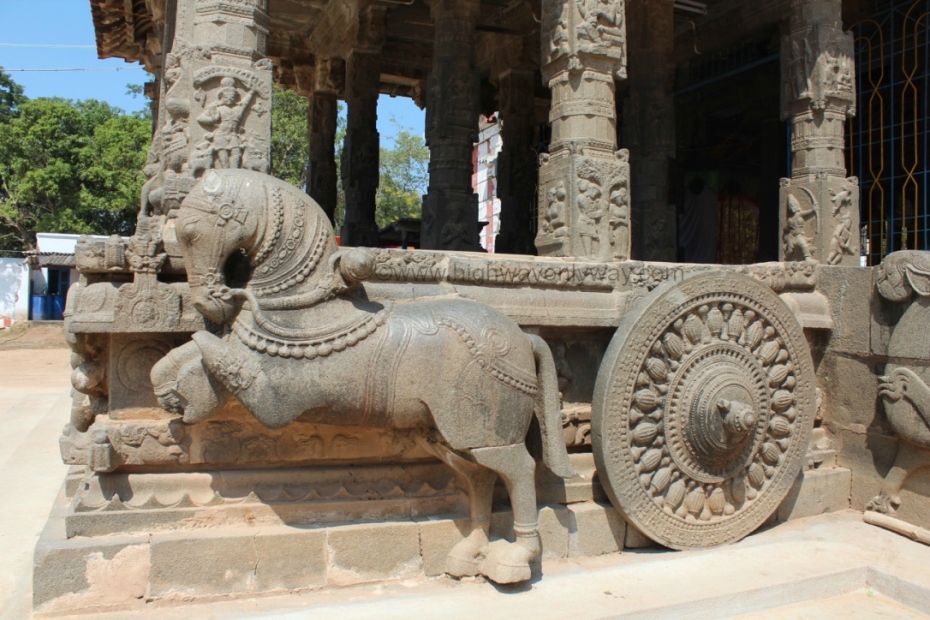 |
| Horse-drawn Chariot with wheels - Note the finer details |
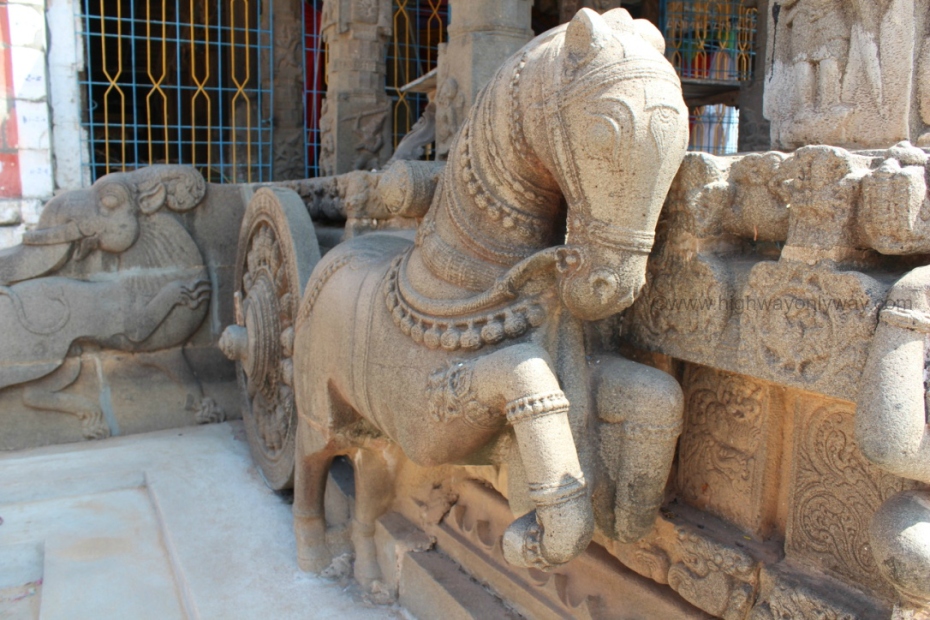 |
| Closer-look of the Horse |
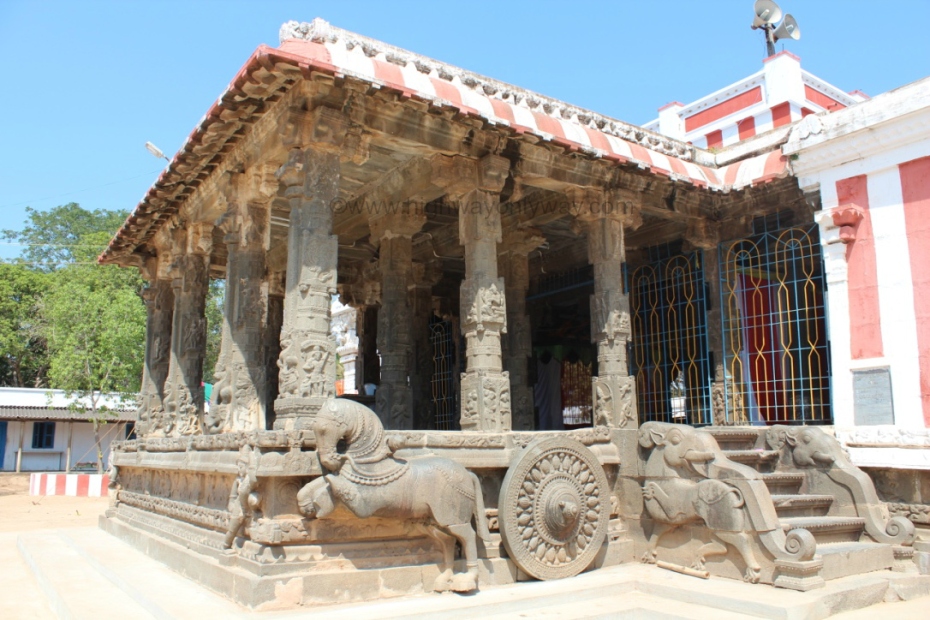 |
| 16 pillared Mandapam - Flight of steps flanked by YALI Balustrade |
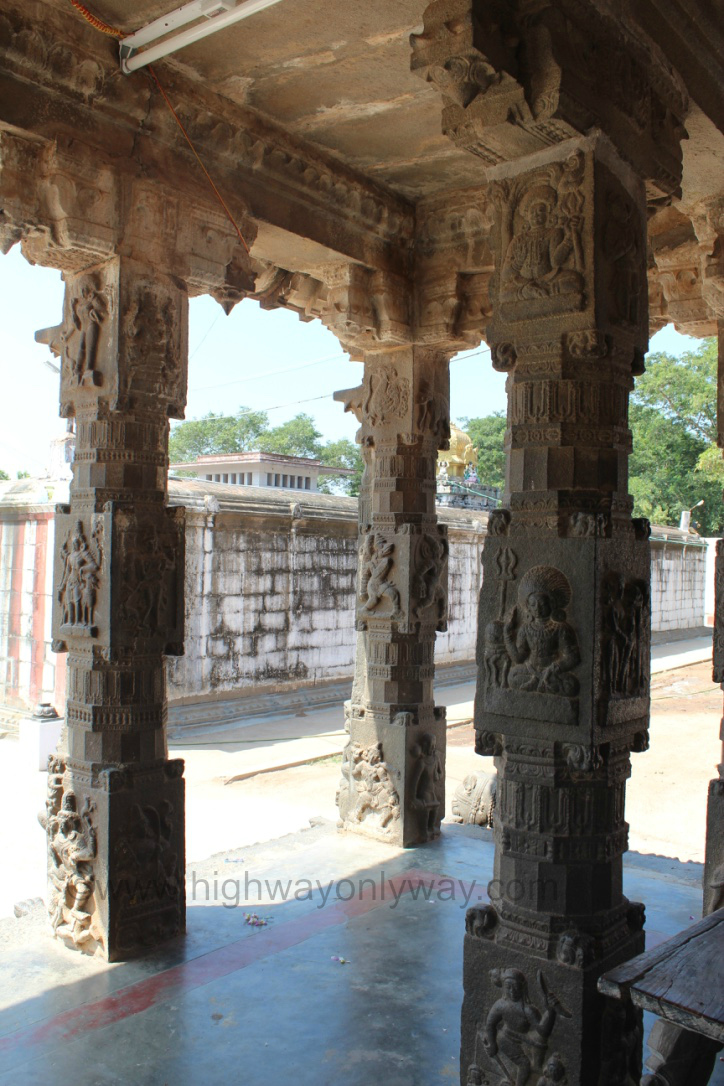 |
| Pillar faces showing bas-relief images |
 |
| Adhishtana - Jagadhi with bas relief panels flanked by yali frieze and kapotam |
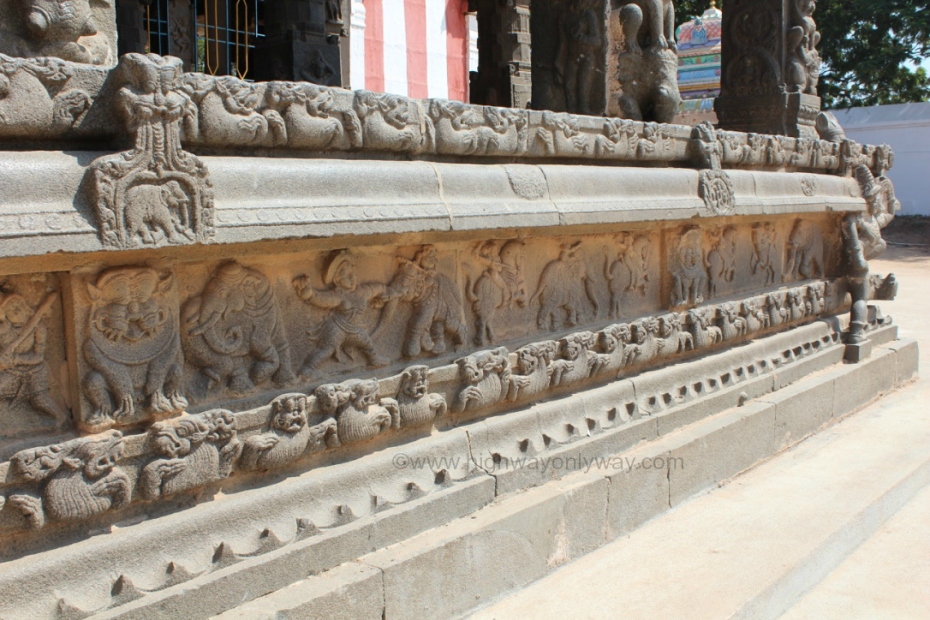 |
| View of Adhishtana of the Mandapam |
Inscription
 |
| Thoongu thalai Navakandam |
Navakandam means nine Cuts. Brave act of the heroic warrior who ritually cuts himself in nine spots in his body and dies in front of Goddess Durga a.k.a Kotravai just to fulfill his vow before a war. He does this supreme sacrifice for the longevity and success of the king as well as his kingdom. The brave individuals who have sacrificed their lives for sake of the country are honored by the countrymen. They install memorial stones for them and offered rituals.
Thoongu thalai navakandam is the rare form of self-sacrifice wherein the warrior ties his tuft with his left hand or ties to a tree and chops his head with a sword held in his right hand.
An inscription of Kampavarman, dated in the 20th year, found on a stone slab set up in front of the Subramanyeswaraswamy temple speaks of a person holding his severed head by the tuft in his left hand, while the right hand grasps a sword. It registers a gift of land made by the urar of Tiruvanmur of Pattai-Pottan for the pious act of Okkondanagan Okkatindan Pattai-Pottan, probably his father, in cutting off flesh from nine parts of his body and finally his head as an offering to the goddess Bhitari, i.e., Durga. (The rituals connected with human sacrifice offered to the goddess Durga are described in the Kaika-Purana, Chapter 70.). The modern Mallam or an ancient suburb of it was known as Tiruvanmur in inscriptions. (S.I.I. Vol. XII, No. 106 - A.R. No. 498 of 1908) Mallam, Gudur Taluk, Nellore District, on a slab set up in front of the Subrahmanya temple)
ஸ்ரீ கம்ப பருமற்கு யாண்டு இருபதாவது பட்டை பொத்தனுக்கு ஒக்கொண்ட நாகர் ஒக்கதீந்தன் பட்டை பொத்தன் மெ (தவம்) புரிந்ததென்று படாரிக்கு நவகண்டங் குடுத்து குன்றகத்தலை அறுத்துப் பிடலிகை மேல்வைத்தானுக்கு திருவான்மூர் ஊரார் வைத்த பரிசாவது : எமூர்ப்பறை கொட்டிக்கல்மெடு செய்தராலிக்குக் குடுப்பரானார் பொத்தனங் கிழவர்களும் தொறுப்பட்டி நிலங் குடுத்தார்கள் . இது அன்றென்னங் கங்கையிடை குமரியிடை எழுநூற்றுக் காவதமும் செய்தான், செய்த பாவத்துப் படுவார். அன்றென்றார் அன்றான் கோவுக்கு காற்பொன் தண்டப்படுவார். S.I.I Vol XII No. 106
Sankaran Sriram, Abhinav Books, has helped me a lot to understand the importance of Mallam (Nellore) temple.
- Reference
- Mallam
- South Indian Inscriptions. Pallava Inscriptions (S.I.I Vol XII No. 106)
- Subramanya Swamy Temple in Mallam
- Sri Subramanyeswara Swamy Temple, Mallam
- மகேந்திர வர்மன் மயிலை சீனி வேங்கடசாமி. பாவை பப்ளிகேஷன்ஸ். சென்னை. 2012. பக். 104.
YouTube
Sri Subramanya Swamy Temple, Mallam, Naidupet, Nellore by M.Sreenivas